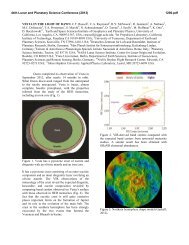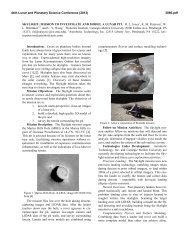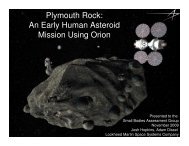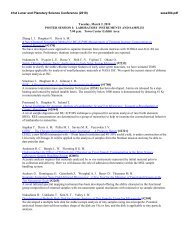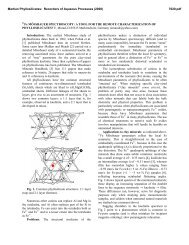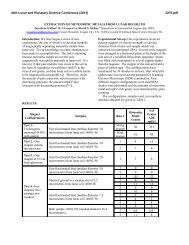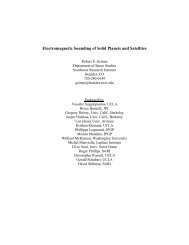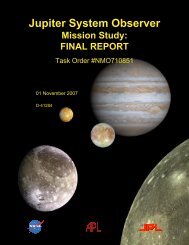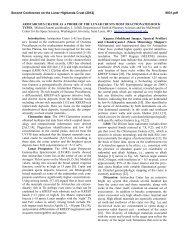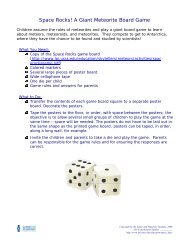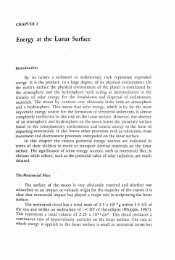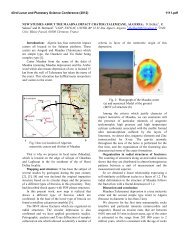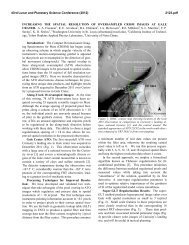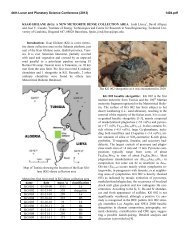Formation of Impact Craters - Lunar and Planetary Institute
Formation of Impact Craters - Lunar and Planetary Institute
Formation of Impact Craters - Lunar and Planetary Institute
You also want an ePaper? Increase the reach of your titles
YUMPU automatically turns print PDFs into web optimized ePapers that Google loves.
,,<br />
,,,<br />
,,,<br />
,,<br />
22 Traces <strong>of</strong> Catastrophe<br />
Fig. 3.4. Excavation stage: formation <strong>of</strong> transient crater. Theoretical cross section showing development <strong>of</strong> the transient crater<br />
immediately after the contact/compression stage. Original peak shock pressures (units in GPa) around the impact point are shown for<br />
simplicity as hemispherical isobars (for details, see Fig. 3.2). Complex interactions <strong>of</strong> the shock wave, the ground surface, <strong>and</strong> the<br />
subsequent rarefaction wave produce an outward excavation flow (dashed arrows) that opens up the transient crater. In the upper part <strong>of</strong><br />
this region (excavated zone; ruled area), target material is fractured, excavated, <strong>and</strong> ejected beyond the transient crater rim. In the lower<br />
region (displaced zone), target material is driven downward <strong>and</strong> outward, more or less coherently, <strong>and</strong> does not reach the surface. This<br />
model yields two important geological results: (1) ejected material is derived only from the upper part (approximately the top one-third<br />
to one-half ) <strong>of</strong> the transient cavity; (2) because the excavation flow lines in the excavated zone cut across the initially hemispherical shock<br />
isobars, ejected material will reflect a wide range <strong>of</strong> original shock pressures <strong>and</strong> deformation effects, ranging from simple fracturing to<br />
complete melting <strong>and</strong> vaporization. (Modified from Grieve, 1987, Fig. 5; Hörz et al., 1991, Fig. 4.3a, p. 67.)<br />
,,<br />
,,<br />
Fig. 3.5. Transient crater: locations <strong>of</strong> shock-metamorphosed materials. Cross section through a theoretical transient crater, showing<br />
discrete zones from which various shock-metamorphosed materials are derived. The “vaporized” zone closest to the original impact point<br />
(stippled) contains a mixture <strong>of</strong> vaporized target rock <strong>and</strong> projectile, which exp<strong>and</strong>s upward <strong>and</strong> outward into the atmosphere as a vapor<br />
plume. The adjacent “melt” zone (solid black) consists <strong>of</strong> melt that moves downward <strong>and</strong> then outward along the floor <strong>of</strong> the final<br />
transient cavity (for details, see Fig. 6.2). Material in the upper “ejected” zones on either side <strong>of</strong> the melt zone, which contains a range <strong>of</strong><br />
shock-metamorphic effects, is ejected outward to <strong>and</strong> beyond the transient crater rim. The lower “displaced” zone moves downward <strong>and</strong><br />
outward to form the zone <strong>of</strong> parautochthonous rocks below the floor <strong>of</strong> the final transient crater. H at = the final transient crater depth;<br />
H exc = the depth <strong>of</strong> excavation, which is significantly less than the total depth. (From Melosh, 1989, Fig. 5.13, p. 78.)



